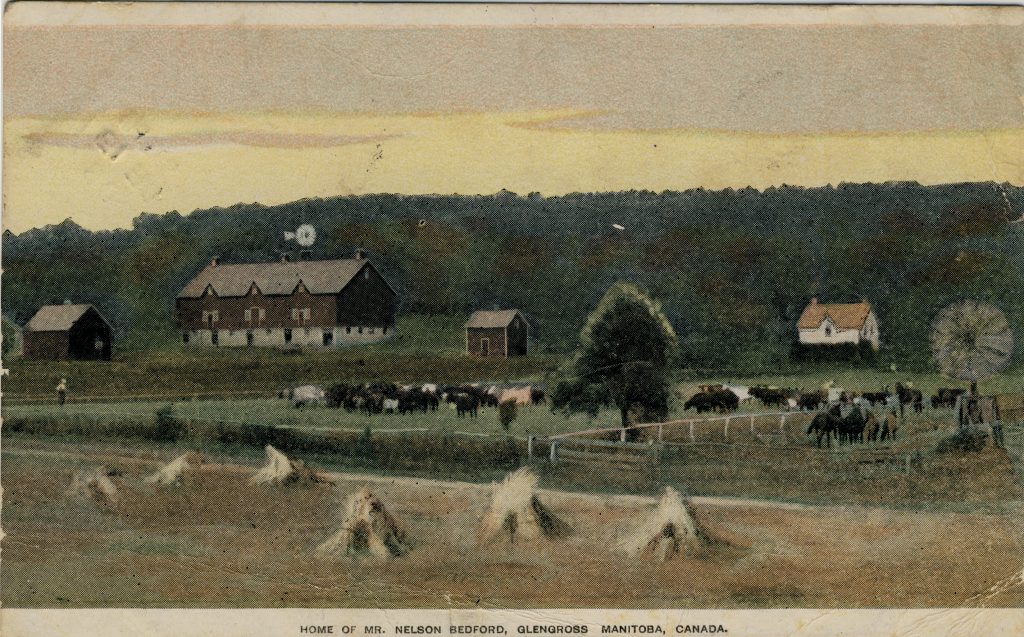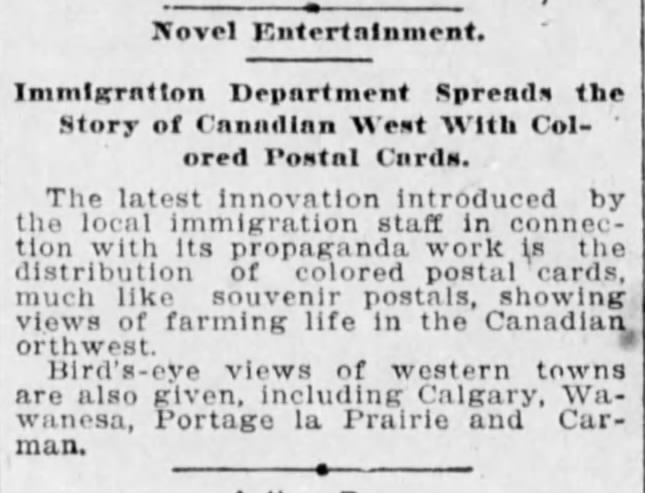By Andrew Cunningham
Twice in its illustrious history — in 1981 and 2013 — the TPC’s magazine Card Talk (free to Club members!) has featured an intriguing set of Prairie postcards known as “Government Agent Cards”. These postcards are so called because their distinctive backs reveal them to have been part of the Dominion Government’s effort to promote immigration to the newly opened farming districts of the Canadian West, with recipients of the cards being urged by the printed text to obtain more information “from any Canadian Government Agent”. Here are the front and back of one of the series of 35 known cards, entitled “Home of Mr. Nelson Bedford, Glengross Manitoba, Canada.”:

Mr. Bedford’s well-established farm may have been in operation for 40 years by the time of this image, making it an attractive candidate for “immigration propaganda” use. This might have been one of the oldest farms on the Prairies outside the immediate vicinity of Winnipeg.
![Home of Mr. Nelson Bedford, Glengross, Manitoba, Canada [back]](https://torontopostcardclub.com/wp-content/uploads/2016/07/Home-of-Mr.-Nelson-Bedford-Glengross-Manitoba-Canada-back-1024x628.jpg)
The postcard may have been handed out as a “freebie” by the Devon Shipping Bureau in an effort to drum up business.
As is still the case, giveaway postcards were often not valued by their recipients and would often end up being used for minor notes such as this. A distinguishing feature of most of the Government Agent cards, illustrated by the Nelson Bedford example, is that they depict specific farms and actually name the owners. In this case, Mr. Bedford turns out to have been one of the earliest (1870s-era) settlers in the Morden, Manitoba district, just a few miles up from the North Dakota line. The reference to “Glengross” should read “Glencross”, but even with that correction the name might not mean much to those in the area today as the Glencross P.O. closed for good in 1909 (by which time Mr. Bedford himself had been dead for two years, after a life that was apparently marked by tragedy).
In my experience, these cards tended to be collected rather than actually mailed, making the well-used example above somewhat uncommon. Of the 28 Government Agent cards in my collection, only 7 were posted — 5 in England and 2 in Canada. An eighth card was presented to a pupil at a school in Oxfordshire as a prize for composition. The predominance of English uses suggests that (as we might have expected) the cards were produced primarily for overseas distribution to potential emigrants.
But when were these cards actually produced, and for how long did the Government distribute them? The postmark dates in my collection suggest fairly specific (if tentative) answers to each of those questions:
Canadian uses
INDIAN HEAD, ASSA. – Sept. 12, 1905
WINNIPEG, MAN. – Nov. 18 [year not readable]
English uses
ROCHESTER, KENT – Oct. 30, 1905
DERBY – Nov. 14, 1905
MELTHAM – Nov. 25, 1905
BANBURY (Hornton National School, prize card) – Dec. 1, 1905 (ink-stamped date)
EXETER – Dec. 19, 1905 (the Nelson Bedford card)
OXFORD – May 9, 1906 (sent by someone actually departing for a 3 month tour of Canada)
Amazingly, all but one of the dated cards from the U.K. were used within a period of about 50 days in 1905. Assuming that the missing year on the Winnipeg card was 1905, the Sept. 12 and Nov. 18 dates of the two Canadian uses suggest the entirely unsurprising possibility that the series was distributed a little earlier in Canada. But it seems that we can date the production of the cards, if only tentatively, to the spring or summer of 1905.
Fortunately, a piece of corroborating evidence has emerged, in the form of a short item published in The Winnipeg Tribune on July 24, 1905. The note appears to refer to a set of cards that is surely these selfsame Government Agent Cards — if only because three of the bird’s-eye views mentioned match the three known examples of bird’s-eye images in the Government Agent set.
The article suggests that this “innovation” may have been the product of the Winnipeg branch of the Dominion immigration department:
Note that the Calgary bird’s eye view doesn’t appear in the list provided by Philip Francis and the late Wayne Curtis in the 2013 Card Talk article, so perhaps that is the 36th card in the series. [ed. Alas, no! See our update post!]
Besides the identity of the printers and the exact number of cards in the series, two great mysteries remain about the Government Agent set: who took the photos and why these particular farms? To these questions I have no answer, other than a very small piece of evidence that Alfred J. Sutton (later of the postcard publisher Gowen Sutton in Vancouver) might possibly have had some involvement. But — to look on the “glass half full” side — we now know that the cards were printed around June or July of 1905 and can further hypothesize (with some “poetic licence” and all due caution) that, after a few had leaked out around Manitoba and Saskatchewan, the bulk of them were shipped off to England for distribution mainly in relatively prosperous counties in the southern half of the country (perhaps with a view to attracting “the right kind” of farmer). Getting the cards into circulation in England must have involved a fairly intensive and concentrated effort by someone over a few weeks in late October and early November 1905.
If anyone can fill in more dates and more places in England and Canada (or elsewhere), we can test and, as warranted, correct the hypothesis! Please feel free to leave a comment if you can help.



Presume you have the card entitled ‘First House Built in Assiniboia, Canada’ in the list already? I have an unposted example here.
Only stumbled on this blog yesterday – read the whole thing in one sitting – excellent! Happy New Year from Canterbury in the UK.
Many thanks for your kind comments. The “First House” is indeed on our current list. No new postcards from this series have turned up in the past few years, suggesting that the 35 we know of might well constitute the entire set. (Andrew Cunningham)